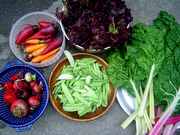

|
| Vegetable Varieties for Gardeners is a citizen science program
|
|
|
|
'Chocolate Bell' Peppers |
| |
| Sub-Category: |
Sweet
|
| |
|
| Sub-Category 2: |
| | Description: |
Hybrid sweet bell type. Plants bear 4 1/2- by 4-inch, smoky-flavored fruit maturing to tan/dark-brown/red. Resistant to tobacco mosaic virus.
|
| Days To Maturity: |
70-75
|
| Seed Sources: |
Underwood Gardens - updated in 2011
|
| |
| Rating Summary |
| |
Overall: (3.5 Stars)
Taste: (4.0 Stars)
Yield: (3.5 Stars)
Ease/Reliability: (3.0 Stars) |
| |
| Reviews |
| |
Login to share your Review of Chocolate Bell.
Number of Reviews: 2
KEY: O=Overall Rating, T=Taste, Y=Yield, E=Ease
Reviewed on 07/20/2008 by
brivari
- An experienced gardener
|
 Overall Overall
 Taste Taste
 Yield Yield
 Ease Ease
|
Suffolk, New York, United States
Frost Free Season: More than 203 days
Soil Texture: Sand
Garden Size: Small - Less than 400 square feet (20' x 20')
Sun Exposure: 6 to 8 hours per day
|
| It's a good pepper but a very heavy feeder. Rich soil boosted with Osmacote and weekly applications of a tomato type fertilizer is a must for this one, It does better in container gardening where it's easier to keep the plants fed. The brown color is strange on the unripe peppers but they go green when cooked. Ripe they go standard red color. Very flavorful, heavy, thick-walled peppers if you can keep them fed. |
| |
|
Reviewed on 07/09/2007 by
farmerdill
- An experienced gardener
|
 Overall Overall
 Taste Taste
 Yield Yield
 Ease Ease
|
Richmond, Georgia, United States
Frost Free Season: 183 - 203 days
Soil Texture: Sand
Garden Size: Large - More than 1,600 square feet (40' x 40')
Sun Exposure: More than 8 hours per day
|
| Chocolate Bell was not competitive here. It produced peppers but yield were low, peppers were smaller than expected and were not visually attractive. |
| |
|
|
|
|
Vegetable Varieties for Gardeners is a citizen science program, © 2004-2024, All Rights Reserved
Cornell Garden Based Learning, Cornell University College of Agriculture & Life Sciences, Horticulture Section
|






 VVfG home
VVfG home
 Taste
Taste